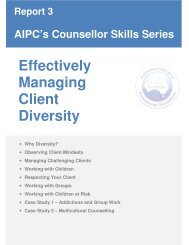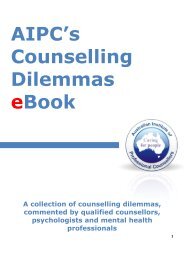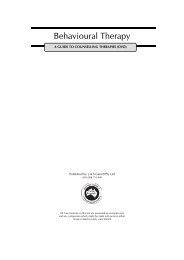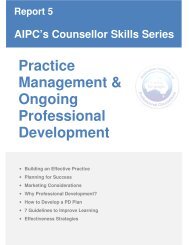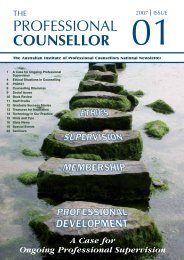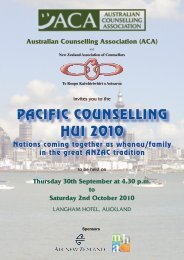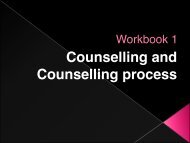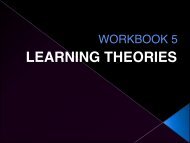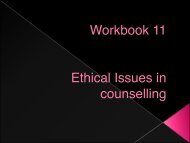Verbal & Non-Verbal Communication Skills - Counselling Connection
Verbal & Non-Verbal Communication Skills - Counselling Connection
Verbal & Non-Verbal Communication Skills - Counselling Connection
Create successful ePaper yourself
Turn your PDF publications into a flip-book with our unique Google optimized e-Paper software.
Report 1<br />
AIPC’s Counsellor <strong>Skills</strong> Series<br />
<strong>Verbal</strong> &<br />
<strong>Non</strong>-<strong>Verbal</strong><br />
<strong>Communication</strong><br />
<strong>Skills</strong><br />
• <strong>Counselling</strong> Microskills – An Overview<br />
• Focusing<br />
• Encouragers, Paraphrasing and Summarising<br />
• Questioning<br />
• Confrontation<br />
• Reflection of Meaning<br />
• Self-Disclosure<br />
• Active Listening<br />
• Body Language – An Overview<br />
• Observation <strong>Skills</strong><br />
• Attending Behaviour<br />
• Empathy
AIPC’s Counsellor <strong>Skills</strong> Series, Report 1<br />
About This Series<br />
“AIPC’s Counsellor <strong>Skills</strong> Series” is a 5-Part Series exploring a range of skills counsellors<br />
can utilise to assist clients in achieving optimal outcomes in life. These reports were<br />
professionally written for Counsellors, Mental Health professionals and other <strong>Counselling</strong><br />
enthusiasts, and are completely free of cost.<br />
We hope you enjoy this reading. We encourage you to forward this publication to friends and<br />
colleagues. If you would like to write feedback, email blog@aipc.net.au.<br />
Kind Regards,<br />
Sandra Poletto<br />
Chief Executive Officer<br />
Australian Institute of Professional Counsellors<br />
Who We Are<br />
The Australian Institute of Professional Counsellors (AIPC) specializes in providing high<br />
quality counsellor education, with a particular focus on external and distance education.<br />
AIPC is the largest provider of counselling courses in Australia, with over sixteen years<br />
experience in delivering counsellor education programs.<br />
We are proud to have helped thousands of people pursue their personal and career interests<br />
in counselling. In fact, over 55,000 people in 27 countries have enjoyed our counselling<br />
courses. Counsellors have a unique opportunity to create a rewarding career helping others<br />
gain a higher level of fulfillment in their lives.<br />
Join us as we tell you about our counselling courses and the many educational services we<br />
offer: www.aipc.net.au/lz.<br />
Join Our Community<br />
Are you a <strong>Counselling</strong> enthusiast? There are many ways you can join our active community!<br />
Simply refer to the links below to subscribe to our free newsletter, keep an eye on our Blog,<br />
or follow us on Twitter!<br />
AIPC on Twitter: http://twitter.com/counsellingnews<br />
<strong>Counselling</strong> <strong>Connection</strong> Blog – www.counsellingconnection.com<br />
Institute Inbrief Newsletter – www.aipc.net.au/ezine<br />
AIPC Article Library – www.aipc.net.au/articles<br />
Page 2
AIPC’s Counsellor <strong>Skills</strong> Series, Report 1<br />
AIPC’s Publications<br />
You can download other AIPC free publications from www.counsellingconnection.com.<br />
Simply visit the URL above and search for the “Free Publications” section on the Right-<br />
Column of the Blog.<br />
AIPC’s Institute Inbrief<br />
A compendium of best articles published in our official newsletter’s<br />
first 50 editions, from 2003 to early 2007.<br />
AIPC’s Case Study Collection<br />
A collection of 20 professionally-written Case Studies, divided into<br />
5 Categories: Counsellor Microskills; <strong>Counselling</strong> Therapies;<br />
Family <strong>Counselling</strong>; Grief and Loss <strong>Counselling</strong>; and Stress<br />
Issues in <strong>Counselling</strong>.<br />
AIPC’s <strong>Counselling</strong> Dilemmas<br />
A compilation of 18 professionally-written counselling dilemmas,<br />
including comments, opinions and strategies from qualified<br />
counsellors, psychologists and mental health professionals.<br />
AIPC’s Five Therapies<br />
An exploration of counselling’s five mainstream therapies’<br />
histories, key concepts, applications, benefits, disadvantages and<br />
processes.<br />
Page 3
AIPC’s Counsellor <strong>Skills</strong> Series, Report 1<br />
Table of Contents<br />
About This Series 2<br />
Who We Are 2<br />
Join Our Community 2<br />
AIPC’s Publications 3<br />
<strong>Verbal</strong> <strong>Communication</strong> <strong>Skills</strong> 5<br />
<strong>Counselling</strong> Microskills – An Overview 5<br />
Focusing 8<br />
Encouragers, Paraphrasing and Summarising 8<br />
Questioning 10<br />
Confrontation 11<br />
Reflection of Meaning 12<br />
Self-Disclosure 12<br />
Active Listening 14<br />
<strong>Non</strong>-<strong>Verbal</strong> <strong>Communication</strong> <strong>Skills</strong> 15<br />
Body Language – An Overview 15<br />
Observation <strong>Skills</strong> 15<br />
Attending Behaviour 17<br />
Empathy 18<br />
References 19<br />
Contacts 20<br />
Page 4
AIPC’s Counsellor <strong>Skills</strong> Series, Report 1<br />
<strong>Verbal</strong> <strong>Communication</strong> <strong>Skills</strong><br />
COUNSELLING MICROSKILLS – AN OVERVIEW<br />
<strong>Counselling</strong> Microskills are specific skills a counsellor can use to enhance their<br />
communication with clients. These skills enable a counsellor to effectively build a working<br />
alliance and engage clients in discussion that is both helpful and meaningful.<br />
Many will be familiar with the skills-development-matrix advocated by the Gordon Training<br />
International Institute in California which illustrates the learning stages of skill development in<br />
four phases: 1. unconscious incompetence, 2: conscious incompetence, 3: conscious<br />
competence and 4: unconscious competence.<br />
Conscious-Competence Model<br />
Source: Gordon Training International, California, USA<br />
To illustrate this concept let’s consider the apprentice carpenter, Stan.<br />
When Stan begins his apprenticeship all he knows is that he loves working with wood. He<br />
saws, chisels and carves pieces of wood to create basic sculptures and amateur pieces of<br />
furniture.<br />
At this stage, Stan is unaware of the enormous learning curve he is about to embark on (i.e.<br />
he is unconscious of what he needs to learn). As he begins his study and watches some of<br />
the experienced carpenters work, he begins to realise how much he has to learn to become<br />
a master of his trade. Stan is now conscious of his incompetence.<br />
Further, as Stan progresses through his apprenticeship he begins to gain new skills (he must<br />
concentrate on holding the wood and the tools at certain angles to bring about the result he<br />
wants). This, at first, takes enormous concentration but he is gaining confidence. Stan is now<br />
conscious of how skilled he is becoming.<br />
Finally, Stan completes his apprenticeship and goes on to open his own business. In a few<br />
years, he is making wonderful pieces of furniture, hardly thinking about what he has to do to<br />
bring about the exquisite results he produces. Stan is now unconsciously competent. He<br />
simply does his work, barely paying attention to the process (sometimes signing along to the<br />
radio in the background). He no longer has to concentrate on every stage of his work.<br />
Page 5
AIPC’s Counsellor <strong>Skills</strong> Series, Report 1<br />
In the same way, counsellors build their skills in communication by progressing through<br />
these stages. Counsellors who are finding the use of micro skills awkward or difficult are<br />
likely to be in the consciously incompetent stage. Counsellors, who are using the skills<br />
effectively but feel a little unnatural or awkward, are likely to be consciously competent. And<br />
counsellors who have learnt the skills thoroughly and are no longer immediately aware that<br />
they are using the skills are unconsciously competent.<br />
It can be reassuring to know that you will progress through the skill-development matrix. It is<br />
only a matter of time and practice before you master the skills and they become second<br />
nature to you.<br />
SUMMARY OF COUNSELLING SKILLS<br />
Micro-skill Purpose When it’s used Examples<br />
Attending<br />
Behaviour<br />
Questioning<br />
Responding<br />
Noting and<br />
Reflecting<br />
Attending behaviours<br />
encourage clients to<br />
talk and show that<br />
the counsellor is<br />
interested in what’s<br />
being said.<br />
Effective questioning<br />
helps guide the<br />
counselling<br />
conversation and<br />
may assist in<br />
enriching the client’s<br />
story.<br />
Accurate<br />
Responding allows<br />
the counsellor to<br />
confirm with the<br />
client that they are<br />
being heard<br />
correctly.<br />
Noting and reflecting<br />
is used to bring out<br />
underlying feelings.<br />
Throughout entire<br />
counselling<br />
interview.<br />
Particularly important<br />
in the initial stages of<br />
establishing rapport.<br />
Questioning is useful<br />
in the information<br />
gathering stage of<br />
the interview. It can<br />
however be an<br />
important skill to use<br />
throughout the entire<br />
process.<br />
Responding is useful<br />
throughout all stages<br />
of a counselling<br />
interview. It helps the<br />
counsellor to clarify<br />
and encourage<br />
clients’ stories.<br />
Noting and reflecting<br />
can assist in adding<br />
the emotional<br />
dimension to the<br />
client’s story, so is<br />
often used in the<br />
interview stages of<br />
gathering information<br />
and exploring<br />
alternatives.<br />
Attentive body language<br />
(eye contact, leaning<br />
forward slightly,<br />
encouraging gestures)<br />
“What would you like to<br />
talk about today?”<br />
“When does the problem<br />
occur?”<br />
“Let me see if I’ve got this<br />
right. You want to go back<br />
to full time study but are<br />
worried about your<br />
financial commitments?”<br />
“You feel disappointed<br />
because your mother<br />
didn’t call you on your<br />
birthday.”<br />
Page 6
AIPC’s Counsellor <strong>Skills</strong> Series, Report 1<br />
Client<br />
Observation<br />
Skilled client<br />
observation allows<br />
the counsellor to<br />
identify<br />
discrepancies or<br />
incongruities in the<br />
client’s or their own<br />
communication.<br />
Confrontation Confrontation is a<br />
skill that can assist<br />
clients to increase<br />
their self-awareness.<br />
It can be used to<br />
highlight<br />
discrepancies that<br />
clients have<br />
previously been<br />
unaware of.<br />
Focusing<br />
Influencing<br />
Focusing enables a<br />
counsellor to direct<br />
client’s<br />
conversational flow<br />
into certain areas.<br />
Influencing may<br />
facilitate change in<br />
the way a client<br />
chooses to think or<br />
act.<br />
Observation is a skill<br />
that is utilised<br />
throughout the entire<br />
counselling<br />
interview.<br />
Confrontation is<br />
often used when the<br />
counsellor observes<br />
mixed messages or<br />
incongruities in the<br />
client’s words,<br />
behaviours, feelings<br />
or thoughts.<br />
Confrontation should<br />
only be used after<br />
rapport has been<br />
developed between<br />
client and counsellor.<br />
Focusing is a skill<br />
that is relevant to all<br />
stages of a<br />
counselling<br />
interview. This skill<br />
however should be<br />
used sparingly.<br />
Influencing is<br />
generally used when<br />
the client is exploring<br />
alternative ways of<br />
thinking or behaving.<br />
Observing body language,<br />
tone of voice and facial<br />
expressions.<br />
“You say you would like to<br />
do further study but you<br />
haven’t contacted the<br />
training institution.”<br />
After noticing that a client<br />
has mentioned very little<br />
about his family, the<br />
counsellor, (believing the<br />
family is relevant) directs<br />
the conversation toward<br />
the client’s family.<br />
A young person has just<br />
started taking drugs. The<br />
counsellor discusses the<br />
possible long and short<br />
term consequences of<br />
his/her actions.<br />
Learn to be a qualified Counsellor with<br />
Australia’s only national counselling education<br />
specialist...<br />
Like so many of our graduates, you will be able<br />
to create lasting change and have a major<br />
positive influence on the wellbeing of people in<br />
your community!<br />
www.aipc.net.au/lz<br />
Page 7
AIPC’s Counsellor <strong>Skills</strong> Series, Report 1<br />
FOCUSING<br />
Focusing enables a counsellor to direct client’s conversational flow into certain areas. It is a<br />
microskill that is relevant to all stages of a counselling interview. This skill however should be<br />
used sparingly.<br />
Example: After noticing that a client has mentioned very little about his family, the<br />
counsellor, (believing the family is relevant) directs the conversation toward the<br />
client’s family.<br />
Ivey and Ivey (2003) have identified seven areas a counsellor can focus on in the<br />
counselling session to bring about broader perspectives and potential solutions.<br />
The first is Individual focus, where the counsellor begins the counselling session by focusing<br />
totally on the personal aspects of the client; the demographics, history, and the reasons why<br />
counselling is sought, from the client. The counsellor will often use the client’s name, to help<br />
bring about total focus on that client. For example, “Joan, tell me a little about yourself”.<br />
“Joan, are you the oldest daughter in the family?”<br />
The second is; Main theme or problems focus. Attention is given to the reason why the client<br />
sought counselling. Other focus, as no problem is truly isolated, the client will often speak of<br />
friends’, colleagues, extended family members and other individuals that are somehow<br />
connected with the reason for the client seeking counselling.<br />
Family focus, concerns siblings, parents, children. Flexibility is required in the definition of<br />
“Family”, as it can have different meanings to different people, i.e. traditional, single parent,<br />
nuclear and/or can include extended family members, or very close friends who are given<br />
family titles such as Aunt or Uncle.<br />
Mutuality focus is concerned with how the client reacts to the counsellor, because this could<br />
be an indication of how the client develops in relation to other people. It attempts to put the<br />
counsellor and client on an equal level, with the counsellor asking: “How can we work<br />
together?” “How would you like me to help with this situation at this point?”<br />
Interviewer focus is where the counsellor may disclose information about themselves.<br />
Finally, Cultural/environmental/context focus. The counsellor will understand how a client is<br />
influenced by the community/ies in which they grew up, but this can be extended to other<br />
issues such as gender, race, ethnicity, religion, socio-economic status to gain a greater<br />
understanding of the person the client is today.<br />
ENCOURAGERS, PARAPHRASING AND SUMMARISING<br />
A counsellor can encourage a client to continue to talk, open up more freely and explore<br />
issues in greater depth by providing accurate responses through encouraging, paraphrasing<br />
and summarising. Responding in this way informs the client that the counsellor has<br />
accurately heard what they have been saying. Encouragers, paraphrases and summaries<br />
are basic to helping a client feel understood.<br />
Encouragers, also known as intentional listening, involve fully attending to the client, thus<br />
allowing them to explore their feelings and thoughts more completely. Paraphrasing and<br />
summarising are more active ways of communicating to the client that they have been<br />
listened to. Summarising is particularly useful to help clients organise their thinking.<br />
Page 8
AIPC’s Counsellor <strong>Skills</strong> Series, Report 1<br />
The diagram below shows how encouragers, paraphrases and summaries are on different<br />
points of a continuum, each building on more of the information provided by the client to<br />
accurately assess issues and events.<br />
Encouragers - Encouragers are a variety of verbal and non-verbal ways of prompting clients<br />
to continue talking.<br />
Types of encouragers include:<br />
• <strong>Non</strong>-verbal minimal responses such as a nod of the head or positive facial<br />
expressions<br />
• <strong>Verbal</strong> minimal responses such as “Uh-huh” and “I hear what you’re saying”<br />
• Brief invitations to continue such as “Tell me more”<br />
Encouragers simply encourage the client to keep talking. For a counsellor to have more<br />
influence on the direction of client progress they would need to make use of other<br />
techniques.<br />
Paraphrases - To paraphrase, the counsellor chooses the most important details of what<br />
the client has just said and reflects them back to the client. Paraphrases can be just a few<br />
words or one or two brief sentences.<br />
Paraphrasing is not a matter of simply repeating or parroting what the client has stated.<br />
Rather it is capturing the essence of what the client is saying, through rephrasing. When the<br />
counsellor has captured what the client is saying, often the client will say, “That’s right” or<br />
offer some other form of confirmation.<br />
Example: I have just broken up with Jason. The way he was treating me was just too<br />
much to bear. Every time I tried to touch on the subject with him he would just clam<br />
up. I feel so much better now.<br />
Paraphrase: You feel much better after breaking up with Jason.<br />
Summaries - Summaries are brief statements of longer excerpts from the counselling<br />
session. In summarising, the counsellor attends to verbal and non-verbal comments from<br />
the client over a period of time, and then pulls together key parts of the extended<br />
communication, restating them for the client as accurately as possible.<br />
A check-out, phrased at the end of the summary, is an important component of the<br />
statement, enabling a check of the accuracy of the counsellor’s response. Summaries are<br />
similar to paraphrasing, except they are used less frequently and encompass more<br />
information.<br />
Page 9
AIPC’s Counsellor <strong>Skills</strong> Series, Report 1<br />
QUESTIONING<br />
Questions during the counselling session can help to open up new areas for discussion.<br />
They can assist to pinpoint an issue and they can assist to clarify information that at first may<br />
seem ambiguous to the counsellor. Questions that invite clients to think or recall information<br />
can aid in a client’s journey of self-exploration.<br />
Counsellors should be knowledgeable about the different types of questioning techniques,<br />
including the appropriate use of them and likely results. It is also important to be aware and<br />
cautious of over-questioning.<br />
Asking too many questions sends a message to the client that the counsellor is in control<br />
and may even set up a situation in which the client feels the counsellor has all the answers.<br />
In determining effective questioning techniques it is important to consider the nature of the<br />
client, their ongoing relationship with the counsellor and the issue/s at hand.<br />
There are two main types of questions used in counselling: (1) Open and (2) Closed.<br />
Open Questions - Open questions are those that cannot be answered in a few words, they<br />
encourage the client to speak and offer an opportunity for the counsellor to gather<br />
information about the client and their concerns.<br />
Typically open questions begin with: what, why, how or could.<br />
For example:<br />
1. What has brought you here today?<br />
2. Why do you think that?<br />
3. How did you come to consider this?<br />
4. Could you tell me what brings you here today?<br />
“How” questions tend to invite the client to talk about their feelings. “What” questions more<br />
often lead to the emergence of facts. “When” questions bring about information regarding<br />
timing of the problem, and this can include events and information preceding or following the<br />
event.“Where” questions reveal the environment, situation or place that the event took place,<br />
and “Why” questions usually give the counsellor information regarding the reasons of the<br />
event or information leading up to the event.<br />
• How? Most often enables talk about feelings and/or process.<br />
• What? Most often lead to facts and information.<br />
• When? Most often brings out the timing of the problem, including what preceded and<br />
followed it.<br />
• Where? Most often enables discussion about the environment and situations.<br />
• Why? Most often brings out reasons.<br />
It should be noted that care must be taken by the counsellor when asking “why” questions.<br />
Why questions can provoke feelings of defensiveness in clients and may encourage clients<br />
to feel as though they need to justify themselves in some way.<br />
Closed Questions - Closed questions are questions that can be answered with a minimal<br />
response (often as little as “yes” or “no”). They can help the counsellor to focus the client or<br />
gain very specific information. Such questions begin with: is, are or do.<br />
Page 10
AIPC’s Counsellor <strong>Skills</strong> Series, Report 1<br />
For example:<br />
• Is that your coat?<br />
• Are you living alone?<br />
• Do you enjoy your job?<br />
While questioning techniques can be used positively to draw out and clarify issues relevant<br />
to the counselling session, there is also the very real danger of over-using questions or using<br />
questioning techniques that can have a negative impact on the session. The wrong types of<br />
questioning techniques, at the wrong time, in the hands of an unskilled interviewer or<br />
counsellor, can cause unnecessary discomfort and confusion to the client.<br />
CONFRONTATION<br />
Generally speaking the term confrontation means challenging another person over a<br />
discrepancy or disagreement. However, confrontation as a counselling skill is an attempt by<br />
the counsellor to gently bring about awareness in the client of something that they may have<br />
overlooked or avoided.<br />
There are three steps to confrontation in counselling. The first step involves the identification<br />
of mixed or incongruent messages (expressed through the client's words or non-verbals).<br />
The second step requires the counsellor to bring about awareness of these incongruities and<br />
assist the client to work through these. Finally, step three involves evaluating the<br />
effectiveness of the intervention evidenced by the client's change and growth.<br />
During the counselling process there are four (4) discrepancies which the client could<br />
display. The discrepancy can be between:<br />
• Thoughts and feelings<br />
• Thoughts and actions<br />
• Feelings and actions or<br />
• A combination of thoughts, feelings and actions.<br />
Having identified a discrepancy, the counsellor highlights this to the client, using a<br />
confrontation statement such as:<br />
"On the one hand ..., but on the other hand...."<br />
This is a standard and useful format for the actual confrontation. Of course, you may also<br />
use variations such as:<br />
"You say ... but you do ...," or<br />
"Your words say ... but your actions say ...."<br />
E.g.: "Your words say you would like to spend more time with your sister, but your actions<br />
say that it's not a priority for you."<br />
Page 11
AIPC’s Counsellor <strong>Skills</strong> Series, Report 1<br />
REFLECTION OF MEANING<br />
Reflection of meaning refers to the deeply held thoughts and meanings underlying life<br />
experiences. For the counsellor who uses reflection of meaning in their work, they will find<br />
that clients will search more deeply into the aspects of their own life experiences.<br />
For example, imagine two individuals who take a holiday on an island resort: the same<br />
island, the same resort, the same time of year. One of them passionately expresses the<br />
wonders of the sunsets, walks along the beach and leisurely life style. While the other<br />
complains about the heat, sunburn and boredom they experienced.<br />
This example illustrates how the same event can have a totally different meaning to the<br />
different individuals experiencing the event. Hence, the skill of reflection of meaning is to<br />
assist clients to explore their values and goals in life, by understanding the deeper aspects<br />
of their experiences.<br />
SELF-DISCLOSURE<br />
The benefits or advantages of self-disclosure include: helping the client to not feel alone,<br />
decreasing client anxiety, improving the client's awareness to different viewpoints, and<br />
increasing counsellor genuineness.<br />
Some disadvantages of applying self-disclosure include: moving focus from the client, taking<br />
too much counselling time (and thus reducing client disclosure), creating role confusion (who<br />
is helping who?), possibly trivialising the client's issue by implying everyone goes through it,<br />
and interfering with transference.<br />
Guidelines for use of self-disclosure - According to Gladding (2006) there are some<br />
guidelines which can help counsellors to effectively implement self-disclosure strategies.<br />
Such guidelines are basically communication skills which can be used to avoid common<br />
pitfalls of this process, such as losing rapport or focus in the situation.<br />
Primarily, the counsellor should be direct, brief, focused and relevant. This will ensure the<br />
self-disclosure process does not lead to time wastage and loss of focus in the client's<br />
situation. Self-disclosure should also not be used frequently (more self-disclosure is not<br />
necessarily better) and should not add to the client's problems and negative outcomes in a<br />
situation.<br />
In essence, the purpose of self-disclosure should be clear to both counsellor and client and<br />
the process should only be used after considering other options, envisaging that there is a<br />
risk of miscommunication and an effect on the balance of power.<br />
Case Study: A Briefing of the Technique<br />
A young man wishes to move out of his family home and seeks a counsellor for help.<br />
The young man is very distressed by the possible change and the effect it could have<br />
on both his parent's and his own life. In the counselling setting, he briefly describes<br />
his motives for moving out; however, he attests that he does not want to cause<br />
emotional strife to his parents.<br />
In that context, he asks the counsellor to help him come up with a way to tell his<br />
parents without hurting them. A solution to that situation would relieve the young man<br />
from his personal anxiety.<br />
Page 12
AIPC’s Counsellor <strong>Skills</strong> Series, Report 1<br />
The counsellor and the client explored all available options and at the end of the<br />
counselling session, the young man is still very emotionally affected by his decision<br />
and its possible outcomes. At that point, self-disclosure was used as a strategy to<br />
help the client move into a positive frame of reference.<br />
The counsellor disclosed that her son left the family home only last year, and even<br />
though it was a very emotional situation for the family, they understood his decision<br />
and moved forward. Nowadays, they regularly meet and have a very positive<br />
relationship. At the end of the counselling relationship, the client felt comfortable with<br />
the knowledge that a similar situation had ended with a positive outcome, and was<br />
able to move forward with his decision without distress.<br />
This example showed the effective use of self-disclosure and how this technique can be<br />
beneficial to clients. It was observable that in that scenario, the following benefits were<br />
achieved: helping the client to not feel alone, decreasing client anxiety and increasing<br />
counsellor genuineness.<br />
Become a Counsellor or Expand on Your<br />
Qualifications with Australia’s Most Cost<br />
Effective and Flexible Bachelor of <strong>Counselling</strong>!<br />
• Save Up To $18,000.00 On Course Fees<br />
• Get Up To A Full Year Credit For Your<br />
Prior Qualifications And Experience<br />
www.aipc.net.au/degree<br />
Learn How You Can Gain Specialty Expertise<br />
And A Graduate Qualification With A Vocational<br />
Graduate Certificate Or Vocational Graduate<br />
Diploma In <strong>Counselling</strong>…<br />
… In Only 6 to 12 Months!<br />
www.aipc.net.au/vgd<br />
Page 13
AIPC’s Counsellor <strong>Skills</strong> Series, Report 1<br />
ACTIVE LISTENING<br />
Active listening is an essential skill counsellors can exploit to develop a positive and healthy<br />
interaction with a client.<br />
“Active listening intentionally focuses on who you are listening to, whether in a group<br />
or one-on-one, in order to understand what he or she is saying. As the listener, you<br />
should then be able to repeat back in your own words what they have said to their<br />
satisfaction. This does not mean you agree with, but rather understand, what they<br />
are saying”.<br />
(Source: www.studygs.net/listening.htm)<br />
There are numerous situations in which counsellors can utilise active listening to build<br />
rapport with clients and improve overall communication. Some of these are explored below.<br />
Information - getting a clear picture. This means asking questions to find out about needs,<br />
instructions and context of a client. Counsellors should check back to ensure they’ve heard<br />
and understood the relevant details, and that the client agrees on the facts.<br />
Aim of the speaker: To tell them what you want.<br />
Aim of the listener: To find out and confirm what they are saying.<br />
Affirmation - affirming, acknowledging, exploring the problem. Listening actively to a<br />
person who would benefit from having their problem acknowledged by the counsellor.<br />
The problem may or may not involve the counsellor directly. Counsellors may reflect back<br />
the client’s feelings and perhaps the content of the problem with a single statement of<br />
acknowledgment or during a dialogue over a period of time, exploring the difficulty in more<br />
depth.<br />
Aim of the speaker: To tell someone (counsellor) about the problem.<br />
Aim of the listener: To help them hear what they are saying. The listener is assisting<br />
the speaker to explore the problem further, so the speaker can find greater clarity<br />
and understanding for themselves.<br />
Inflammation - responding to a complaint. When clients tell the counsellor they are<br />
unhappy with them, criticising them, complaining about them, or getting it off their chest, the<br />
best thing the counsellor can do (although challenging) is to effectively listen.<br />
Aim of the speaker: To tell the counsellor that they are the problem.<br />
Aim of the listener: Let them know that they have taken in what they are saying and<br />
to defuse the strong emotion.<br />
When there is conflict it is very common to blame the other person. It is challenging to be<br />
objective when the emotional level is high. Active listening is an effective tool to reduce the<br />
emotion of a situation. Every time the counsellor correctly labels an emotion, the intensity of<br />
it dissipates like bursting a bubble.<br />
The speaker feels heard and understood. Once the emotional level has been reduced,<br />
reasoning abilities can function more effectively. If the emotions are high, counsellors should<br />
deal with the emotions first by using active listening skills. Effective use of active listening<br />
skills can turn a challenging situation into a co-operative situation.<br />
Page 14
AIPC’s Counsellor <strong>Skills</strong> Series, Report 1<br />
<strong>Non</strong>-<strong>Verbal</strong> <strong>Communication</strong> <strong>Skills</strong><br />
BODY LANGUAGE – AN OVERVIEW<br />
“Fie, fie upon her! There's language in her eye, her cheek, her lip. Nay, her foot<br />
speaks; her wanton spirits look out at every joint and motive of her body.”<br />
William Shakespeare’s quote is one of many epic statements that illustrate the complexity of<br />
body language. The most prevalent form of communication since pre-historic times, body<br />
language can express subtle feelings of a client - particularly in instances without words to<br />
reveal.<br />
The word “language” is often associated with spoken or written language. After all, it is this<br />
unique ability that separates humans from other primates. But despite the association, body<br />
language reigns supreme when it comes to volume of messages. In some interactions, over<br />
90% of the communication is exchanged non-verbally.<br />
Body language is often “taken for granted” because in many instances, it occurs on an<br />
involuntary or semi-voluntary basis. For example, the human face has around 90 muscles<br />
and just about 30 exclusively expressing emotions. Most of the communication which is<br />
represented by changes in facial muscles is biologically-inherited and unconscious.<br />
Nevertheless, there are several cues which can indicate how a person is feeling or what they<br />
are thinking through facial expressions.<br />
We also do semi-conscious or automated body movements. These movements can<br />
represent certain mental dispositions and in many instances, we don’t notice them at all.<br />
“We all, in one way or another, send our little messages out to the world... And rarely<br />
do we send our messages consciously. We act out our state of being with nonverbal<br />
body language. We lift one eyebrow for disbelief. We rub our noses for puzzlement.<br />
We clasp our arms to isolate ourselves or to protect ourselves. We shrug our<br />
shoulders for indifference, wink one eye for intimacy, tap our fingers for impatience,<br />
slap our foreheads for forgetfulness. The gestures are numerous, and while some<br />
are deliberate... there are some, such as rubbing our noses for puzzlement or<br />
clasping our arms to protect ourselves, that are mostly unconscious.” (Julius Fast,<br />
Body Language)<br />
OBSERVATION SKILLS<br />
By accurately observing non-verbal behaviour, a counsellor can gauge the affect her/his<br />
words and actions have upon the client. For example, when a client enters into the office of<br />
the counsellor, the counsellor can gain some indication of how the client is feeling about the<br />
session (are they reticent, comfortable, awkward?) by the way the client walks in, takes their<br />
seat, and greets the counsellor.<br />
If a client is resentful about the counselling session taking place, they may keep their eyes<br />
lowered, seem dismissive of the counsellor and sit in a closed position, not encouraging<br />
communication.<br />
Page 15
AIPC’s Counsellor <strong>Skills</strong> Series, Report 1<br />
A counsellor can also gauge the effectiveness of their words by carefully observing the facial<br />
expression and eye contact of a client. If a counsellor asks a question that the client may find<br />
embarrassing to answer, the client may lower their eyes, or their head, or look away. This<br />
will tell the counsellor that the client might be uncomfortable with that statement or question.<br />
Facial Expressions - There are three sources of information about an individual’s feelings<br />
and thoughts in the visual channel: facial expression, posture and gestures. Facial<br />
expression is considered most prominent source of information about emotions by many<br />
researchers and scientists.<br />
The study of facial expressions began over one hundred years ago with Charles Darwin. The<br />
famous biologist published a book entitled The Expression of the Emotions in Man and<br />
Animals after years of observation and noting. Darwin’s conclusions regarding the link<br />
between facial expressions and emotions have been supported by most modern research.<br />
Eye Accessing Cues - Eye signals are one of the most ‘eloquent’ forms of facial<br />
expression. The presence of eye contact normally determines whether a person is interested<br />
in a certain conversation. If the individual stares uneasily to his or her interlocutors, it he or<br />
she may be intimidated; whilst a ‘direct stare’ is commonly associated with aggression<br />
and/or a challenging stance.<br />
Brain research has also enabled scientists to directly associate certain facial movements<br />
with thinking processes. Eye accessing cues are an example of those. Following are six<br />
distinguishable cues (applied to a normally organised right-handed person):<br />
• Looking left and up: visual recall (recalling a visual memory)<br />
• Looking left and centrally: auditory recall (recalling a noise or sound)<br />
• Looking left and down: auditory internal dialogue<br />
• Looking right and up: visual construction (imagining an image, not factual)<br />
• Looking right and centrally: auditory construction (imaging a sound, not factual)<br />
• Looking right and down: kinaesthetic (imaging a kinaesthetic sensation, not factual)<br />
These cues are often used by police officers in interviews, in order to determine whether the<br />
person is lying about particular questions. However, it can be useful in any context: personal,<br />
business, etc.<br />
Practical exercise: Ask a friend to recall something he or she has experienced and<br />
something that he or she will need to imagine (mentally create). Observe the eye accessing<br />
cues.<br />
Posture and Gestures - Posture and gestures provide several cues to an individual’s<br />
personality, self-perception and mental disposition. Much about gestures is culturally-related:<br />
the Italian people, for instance, are known for their hand gestures while conversing between<br />
each other and with others. It is referred as a body cue to the energy level, or passion, that<br />
they speak about some topics.<br />
A person’s posture often indicates his or her disposition in a conversation. When people are<br />
uninterested during communication, they often demonstrate that by crossing their arms or<br />
legs or pointing their body away from the interlocutor.<br />
Page 16
AIPC’s Counsellor <strong>Skills</strong> Series, Report 1<br />
Inclining back during a conversation is a sign of comfort and perceived power; normally used<br />
in hierarchical situations such as job interviews or a work meeting. Particular postures are<br />
also, in many scenarios, an agreed convention: people are expected to have a certain<br />
posture in a corporate meeting, at a classroom, at a social event, and so on.<br />
Behavioural Discrepancies - Voltaire once said: “one great use of words is to hide our<br />
thoughts”. People often do use words to hide feelings, emotions and thoughts. It may be the<br />
result of someone’s unwillingness to reveal a weakness, or perhaps an attempt to avoid<br />
conflict by contrasting a friend’s opinion. Despite their motives, the majority of individuals find<br />
it difficult to hide their feelings – and that becomes more apparent when they present<br />
behavioural discrepancies.<br />
Behavioural discrepancies are basically the incongruence between someone’s words or<br />
actions, and their body language. For instance, imagine the following scenario: it is 1 o’clock<br />
in the morning when your neighbour knocks at your door asking for ice (he ran out of ice in<br />
his party). You smile weakly and say that it would not be a problem. Although your words<br />
signified acceptance, your body language was of despise and anger. When people get<br />
frustrated, they are likely to ‘fake’ their feelings to avoid unnecessary conflict (depending on<br />
the level of frustration, naturally).<br />
In most situations, it is easier to pick up behavioural discrepancies by observing a person’s<br />
eyes – they are harder to hide. The old adage “the eyes are the window to the soul” is not<br />
only poetic assertion, but a practical and highly applicable point when it comes to body<br />
language.<br />
ATTENDING BEHAVIOUR<br />
Attending is the behavioural aspect of building rapport. When a counsellor first meets with a<br />
client, they must indicate to the client that they are interested in listening to them and helping<br />
them. Through attending, the counsellor is able to encourage the client to talk and open up<br />
about their issues.<br />
Eye contact is important and polite (in Western society) when speaking or listening to<br />
another person. This does not mean that the counsellor stares at the client, but maintains<br />
normal eye contact to show genuine interest in what the client is saying.<br />
Geldard and Geldard (2001) suggest that to assist clients to relax, counsellors can include in<br />
their repertoire, the matching of non-verbal behaviour. This skill can take a little time to learn<br />
effectively, but it begins with the counsellor sitting in the same position as the client.<br />
For example, if at first the client is sitting on the edge of her chair with her arms outstretched<br />
resting on her knees the counsellor can reflect or mirror this position.<br />
As the client speaks more, the counsellor can either lean forward, to indicate empathy and<br />
understanding, or slowly slide back into the chair to take up a more relaxed sitting position. If<br />
the rapport has begun to be built between client and counsellor, the client is likely to follow<br />
suit. This will reduce the anxiety levels for the client.<br />
<strong>Counselling</strong> consists mainly of listening and talking, but sometimes the use of silence can<br />
have profound effects on the client in the counselling session. When we first begin as<br />
counsellors, sometimes silence can be awkward and we rush to fill the gaps, but as our<br />
experience grows, we become more comfortable with the concept of simply "being" with the<br />
client.<br />
Page 17
AIPC’s Counsellor <strong>Skills</strong> Series, Report 1<br />
EMPATHY<br />
A requirement for being an effective counsellor is being able to practice and impart the skill<br />
of empathy in the client-counsellor interaction. Being empathetic ensures you are listening<br />
and dealing with the client's concerns as they present them. You are not judging them.<br />
Some issues for you to remember when considering the issue of empathy when dealing with<br />
challenging clients.<br />
Intensity - responding to the feelings expressed at the appropriate level of intensity e.g. if<br />
you are working with a client. They are very agitated, about to be evicted and their mother is<br />
sick. Your response is "You are a bit upset". The client becomes distant - you have not<br />
reflected his/her level of emotion accurately.<br />
Context - take all aspects into account, not just word and non-verbal behaviour. A lot of<br />
people we come into contact with have multiple problems in their lives. They may behave in<br />
ways we find inappropriate but taken in context of their experience are understandable.<br />
Selective responding - sometimes it may be appropriate to respond only to feelings or<br />
behaviour. Some clients do not respond well to discussing their feelings, and in these cases<br />
it is useful to focus on more concrete elements, such as experience and behaviour.<br />
When your empathic responses have been successful, it is evident from the client's<br />
response, a nod of the head, or a positive verbal response. If your empathic responses have<br />
not been accurate, the client will indicate this non-verbally by stopping, fumbling or becoming<br />
frustrated.<br />
Being aware of these signs will assist you in relating to a client. You may need to adjust your<br />
approach if the client is not responding to you. By using empathy in your interactions with<br />
clients you will:<br />
1. Build the relationship<br />
2. Stimulate self-exploration<br />
3. Check understanding<br />
4. Provide support<br />
5. Assist communication<br />
6. Focus attention on the client<br />
(Hanna, 2001)<br />
Page 18
AIPC’s Counsellor <strong>Skills</strong> Series, Report 1<br />
References<br />
→ Gladding, S.T. (2006). Counseling: A Comprehensive Profession. Upper Saddle<br />
River, NJ: Prentice Hall.<br />
→ Geldard, D., & Geldard, K. (2001). Basic personal counselling: A training manual for<br />
counsellors. French’s Forest, NSW: Pearson Education Australia.<br />
→ Hanna, F.J. (2001). Therapy with challenging clients using the precursor’s model to<br />
awaken change. Washington: APA.<br />
→ Ivey, A., & Ivey M. (2003). Intentional interviewing and counselling: Facilitating client<br />
development in a multicultural society. California, USA: Brooks/Cole - Thomson<br />
Learning.<br />
Page 19
AIPC’s Counsellor <strong>Skills</strong> Series, Report 1<br />
Contact Us To Start Your Passionate Career<br />
Helping Others Lead Better Lives, Today!<br />
The Australian Institute of Professional Counsellors (AIPC) specializes in providing high<br />
quality counsellor education, with a particular focus on external and distance education.<br />
AIPC is the largest provider of counselling courses with over sixteen years experience in<br />
delivering counsellor education programs.<br />
For further information, visit www.aipc.net.au/lz.<br />
Student Support Centres – call now to request further course information:<br />
Brisbane 1800 353 643<br />
Sydney 1800 677 697<br />
Victoria 1800 622 489<br />
Adelaide 1800 246 324<br />
Perth 1800 246 381<br />
Reg QLD 1800 359 565<br />
Reg NSW 1800 625 329<br />
Singapore 800 1301 333<br />
New Zealand 0011 64 9919 4500<br />
United Kingdom 020 3287 0317<br />
The Australian Institute of Community Services (AICS) is a leading national provider of<br />
Community Services qualifications. AICS delivers training nationally through its State-based<br />
network of training and support centres.<br />
For further information, visit www.aics.net.au/lz.<br />
Student Support Centres – call now to request further course information:<br />
Brisbane 1800 754 644<br />
Sydney 1800 637 276<br />
Victoria 1800 637 518<br />
Adelaide 1800 637 598<br />
Perth 1800 637 236<br />
Reg QLD 1800 334 348<br />
Reg NSW 1800 637 276<br />
Page 20



